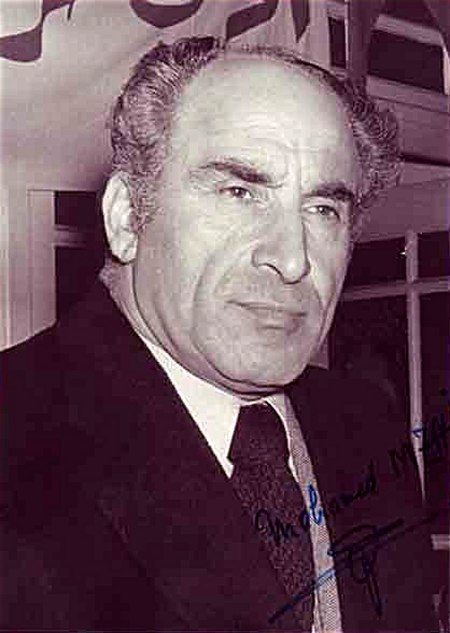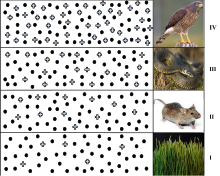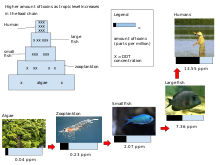Biomagnification
|
Read other articles:

Japanese Association of Independent Television Stations You can help expand this article with text translated from the corresponding article in Japanese. (December 2009) Click [show] for important translation instructions. View a machine-translated version of the Japanese article. Machine translation, like DeepL or Google Translate, is a useful starting point for translations, but translators must revise errors as necessary and confirm that the translation is accurate, rather than simply co…

Stadion HoheluftFull nameStadion HoheluftLocationHamburg, GermanyOwnerSC Victoria HamburgOperatorSC Victoria HamburgCapacity37,000 (record) 11,000 (current)OpenedSeptember 1907TenantsSC Victoria HamburgFC St. Pauli IIHamburg Sea Devils (ELF) (2021–present) Stadion Hoheluft is a Football stadium in Eppendorf, Hamburg, Germany . It is used as the stadium of SC Victoria Hamburg matches. The capacity of the stadium is 11,000 spectators. The record attendance for the ground was 37,000 during the fi…

1899 battle of the Second Boer War Battle of ElandslaagtePart of Second Boer WarPositions at noon, before the battleDate21 October 1899LocationElandslaagte, KwaZulu-Natal, South Africa28°24′S 29°57′E / 28.400°S 29.950°E / -28.400; 29.950 (Battle of Elandslaagte)Result British victoryBelligerents United Kingdom South African RepublicCommanders and leaders John FrenchIan Hamilton Johannes Kock †Adolf SchielStrength 3,50018 guns[1] 1,000…

1977 live album by V.S.O.P.Tempest in the ColosseumLive album by V.S.O.P.Released1977RecordedJuly 23, 1977VenueDenen Coliseum, Ōta, Tokyo, JapanGenreJazzLength68:50LabelCBS/SonyProducerHenri Renaud, David RubinsonV.S.O.P. chronology The Quintet(1977) Tempest in the Colosseum(1977) V.S.O.P. Live Under the Sky(1979) Tempest in the Colosseum was recorded on July 23, 1977 in the Denen Coliseum in Tokyo, Japan. Musicians for this performance were Herbie Hancock on keyboards, Freddie Hubbard …

Group of mountains near Da Nang, Vietnam This article is about the hills. For the area, see Ngũ Hành Sơn District. You can help expand this article with text translated from the corresponding article in Vietnamese. (March 2009) Click [show] for important translation instructions. View a machine-translated version of the Vietnamese article. Machine translation, like DeepL or Google Translate, is a useful starting point for translations, but translators must revise errors as necessary and …

Mammalian protein found in humans KLK3Available structuresPDBOrtholog search: M0QZF9 PDBe M0QZF9 RCSB List of PDB id codes2ZCH, 2ZCK, 2ZCL, 3QUMIdentifiersAliasesKLK3, APS, KLK2A1, PSA, hK3, kallikrein related peptidase 3, Prostate Specific AntigenExternal IDsOMIM: 176820 MGI: 97320 HomoloGene: 68141 GeneCards: KLK3 Gene location (Human)Chr.Chromosome 19 (human)[1]Band19q13.33Start50,854,915 bp[1]End50,860,764 bp[1]Gene location (Mouse)Chr.Chromosome 7 (mouse)[2]B…

الجائزة الأدبية هي الجائزة المقدمة للاعتراف والإشادة بعمل أو قطعة أدبية.[1][2][3] وتقدم عادة إلى المؤلف. المنظمات معظم الجوائز الأدبية تأتي في حفل توزيع الجوائز. العديد من الجوائز تنظم مع منظمة واحدة (عادة ما تكون غير ربحية) كمقدم للجائزة ومنظمة أخرى كراعي مالي أ�…

Lepas landas dan mendarat vertikal (bahasa Inggris: Vertical Take-Off and Landing, VTOL) adalah metode lepas landas dan mendarat secara vertikal. Pesawat dengan metode ini dirancang untuk digunakan tanpa memerlukan ruangan atau area yang cukup besar bagi lepas landas dan mendarat. Pesawat yang memiliki kemampuan ini umumnya adalah helikopter ataupun pesawat jet yang dirancang kusus yang umumnya digunakan oleh militer seperti Harrier, Yak-38 Yak-141, ataupun pesawat tempur JSF. BAE-McDonell-D…

Style of spontaneously fermented beer LambicBottled lambic beersCountry of originBelgiumYeast typeSpontaneous fermentationAlcohol by volume2–8%Color (SRM)Yellow or pale to deep gold or dark red (when made with certain fruits, see below)Malt percentage66% Lambic (English: /lɒ̃bikˌ ˈlæmbɪk/) is a type of beer brewed in the Pajottenland region of Belgium southwest of Brussels and in Brussels itself since the 13th century.[1] Types of lambic beer include gueuze, kriek lambic, and fra…

Protestant separatists from Nottinghamshire, England The Scrooby Congregation were English Protestant separatists who lived near Scrooby, on the outskirts of Bawtry, a small market town at the border of Yorkshire, Lincolnshire and Nottinghamshire. In 1607/8 the Congregation emigrated to the Netherlands in search of the freedom to worship as they chose. They founded the English separatist church at Leiden, one of several English separatist groups in the Netherlands at the time. History Richard Cl…

PabelanKecamatanPeta lokasi Kecamatan PabelanNegara IndonesiaProvinsiJawa TengahKabupatenSemarangPemerintahan • CamatHabib Sholeh, M.PdPopulasi • Total- jiwaKode pos50771Kode Kemendagri33.22.05 Kode BPS3322050 Luas47,97 km²Desa/kelurahan17 Pabelan (bahasa Jawa: ꦥꦧꦺꦭꦤ꧀, translit. Pabélan) adalah sebuah kecamatan di Kabupaten Semarang, Jawa Tengah, Indonesia. Kecamatan ini berjarak sekitar 30 kilometer dari ibukota kabupaten Semarang ke arah teng…

رمز التحذير قابلية الاشتعال أو قابلية الالتهاب[1] ترجع لمدى السهولة التي تشتعل بها المادة لتسبب نار أو احتراق.[2][3][4] المواد التي تشتعل في درجات الحرارة العادية تعتبر قابلة للاشتعال، باختلاف التعريفات النوعية لدرجة الحرارة. فمثلا، نقطة الوميض هي أهم الخصائص �…

Ron BrownsteinBrownstein in 2016Born (1958-04-06) April 6, 1958 (age 66)New York City, New York, U.S.EducationB.A. State University of New York at BinghamtonOccupation(s)Journalist Political correspondentAnalystSpouse(s)Nina Easton (divorced) Eileen Nicole McMenamin (m. 2005)Children2Parent(s)Shirley and David Brownstein Ronald J. Brownstein (born April 6, 1958) is an American journalist, political correspondent, and analyst.[1][2] Earl…

Prime Minister of Tunisia (1980–1986) Mohamed Mzaliمحمد مزاليPrime Minister of TunisiaIn office23 April 1980 – 8 July 1986Preceded byHédi Amara NouiraSucceeded byRachid Sfar Personal detailsBorn(1925-12-23)23 December 1925Monastir, TunisiaDied23 June 2010(2010-06-23) (aged 84)Paris, FrancePolitical partySocialist Destourian PartySpouseFethia Mzali (1950–2010) Mohammed Mzali (Arabic: محمد مزالي, 23 December 1925 – 23 June 2010) was a Tunisian politician wh…

American baseball player (1914-2004) Baseball player Harry BrecheenBrecheen with the Baltimore Orioles in 1955PitcherBorn: (1914-10-14)October 14, 1914Broken Bow, Oklahoma, U.S.Died: January 17, 2004(2004-01-17) (aged 89)Bethany, Oklahoma, U.S.Batted: LeftThrew: LeftMLB debutApril 22, 1940, for the St. Louis CardinalsLast MLB appearanceSeptember 13, 1953, for the St. Louis BrownsMLB statisticsWin–loss record133–92Earned run average2.92Strikeouts901 Teams St…

Luis Muñoz de Guzmán Retrato en óleo de Luis Muñoz de Guzmán. Gobernador del Reino de ChilePresidente de la Real Audiencia 30 de enero de 1802-11 de febrero de 1808Monarca Fernando VIIPredecesor Francisco Tadeo Díez de MedinaSucesor Juan Rodríguez Ballesteros 26.º Presidente de la Real Audiencia de Quito 1791-1797Monarca Carlos IVPredecesor Antonio Mon y VelardeSucesor Francisco de CarondeletVirrey José Manuel de Ezpeleta Información personalNacimiento 1735 Sevilla, Sevilla, Reino de E…

Ligurian dialect spoke historically spoken from Monaco to Italian Imperia IntemeliointemelioNative toMonaco, France, ItalyNative speakers(undated figure of approximately 10,000[citation needed])Language familyIndo-European RomanceWesternGallo-RomanceGallo-ItalicLigurianIntemelioLanguage codesISO 639-3–GlottologNoneLinguasphere51-AAA-ohb (Imperia) Monaco -with Menton- was the extreme western area of the Republic of Genoa (green color) in 1664. Intemelio was spoken in this area, pri…

في اللا لا لاند النوع كوميدي تأليف هشام جمال إخراج أحمد الجندي بطولة دنيا سمير غانم - سمير غانم محمد سلام - محمد ثروتهنا الزاهد - حمدي المرغني - شيماء سيف البلد مصر لغة العمل العربية عدد الحلقات 30 مدة الحلقة 45 دقيقة شارة البداية دنيا سمير غانم موسيقي أمير طعيمة منتج روزناما �…

يفتقر محتوى هذه المقالة إلى الاستشهاد بمصادر. فضلاً، ساهم في تطوير هذه المقالة من خلال إضافة مصادر موثوق بها. أي معلومات غير موثقة يمكن التشكيك بها وإزالتها. (ديسمبر 2018) جبل أهنم تقسيم إداري البلد اليمن مديرية مديرية الرجم المسؤولون محافظة محافظة المحويت خصائص جغرافية إح�…

Questa voce sull'argomento chimica è solo un abbozzo. Contribuisci a migliorarla secondo le convenzioni di Wikipedia. Segui i suggerimenti del progetto di riferimento. Soluzione salina preparata a partire da acqua e cloruro di sodio (sale da cucina). Una soluzione acquosa è una soluzione nella quale il solvente è costituito da acqua. Normalmente nelle equazioni chimiche è indicata aggiungendo (aq) alla rispettiva formula chimica. Per esempio una soluzione di cloruro di sodio (NaCl) in a…


